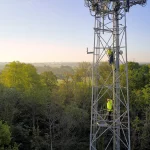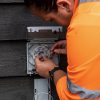New Study Examines UK Full Fibre Broadband Take-up by Age of Network

Strategic consultancy firm Eight Advisory has today published the third edition of their Takeup Tracker, which examines the rise in take-up across the UK’s many alternative full fibre (FTTP) broadband networks (altnets) and compares it with that of Openreach (BT). This edition also takes a deeper dive into take-up by age of network – a key factor in gauging progress.
At present nearly 88% of UK premises can now access a gigabit-capable broadband network or 78% when only looking at Fibre-to-the-Premises (FTTP) technology (here). Ofcom separately predicts the UK will achieve gigabit coverage of between 97-98% and full fibre coverage of between 95-96% by May 2027 (here).
Network coverage is a key measure when assessing progress, but in a market under so much economic strain (e.g. rising build costs and high interest rates) – and filled with so many competitive altnets (i.e. in the case of overbuild this means splitting customers between several competing networks) – it’s also very important to understand the impact of take-up by customers (residential homes, businesses etc.).
Advertisement
We know from our own experience in this market that a number of factors can impact take-up, such as the higher prices for faster services, the amount of local competition, as well as a lack of general awareness (i.e. locals don’t always know that the faster service exists) or interest in the new connectivity (not everybody may feel a need to get something better). The fear of switching to a different ISP may also obstruct some services, and so can long contract terms with existing packages (customers can’t switch immediately).
In addition, it’s important to remember that take-up – usually expressed as a percentage of customers connected within the network area – is somewhat of a dynamically scaled measurement, which is often suppressed while operators are in their rapid roll-out phase (i.e. covering new premises at a faster rate than customers can take it up). But the figure tends to mature faster as the build phase slows in favour of greater commercialisation, which is a process that a lot of altnets are currently going through.
Results of the take-up study
Overall, altnet penetration has slowly increased over the 6 months since the last report, which means that altnet penetration at aggregate level is now estimated to be 20% in March 2025 (up 3% from the 17% the study reported in September 2024). In the same timeframe, Openreach’s FTTP take-up rose to 36% (up 1% since Sept 2024), which is despite the operator adopting an accelerated rate of build.
At a total retail market share level, altnets are also continuing to make incremental gains in capturing market share from the five largest broadband ISPs, now accounting for around 13.4% of retail connections. This compares with BT (inc. EE and Plusnet) on 30.5%, Virgin Media (O2) on 19.7%, Sky Broadband on 20%, TalkTalk on 10.8% and Vodafone with 5.6%.
Advertisement
However, one catch above is that some providers – like TalkTalk and Vodafone, also work with altnets (i.e. we don’t know precisely how many of their customers come from those, although with TalkTalk it’s believed to be c.150k from just CityFibre). Openreach dominates many of the biggest providers (except VMO2), but they also suffered annualised broadband line losses to the year ending March of 828,000 (mostly from their non-FTTP network areas).
By comparison, the new study estimates that altnets cumulatively added 760k net adds over the same period as Openreach lost 828k. Virgin Media also suffered a smaller decline.

The picture is thus somewhat mixed, depending upon the aforementioned issues, such as current rate of build, competition and scale etc. For example, Netomnia and Openreach are both still deploying at a fair old rate of knots, so we don’t expect to see dramatic changes in their take-up rate.
Advertisement
On the other hand, G.Network’s build has been through a few stops and starts, yet their take-up remains among the weakest. We should caveat that toob’s take-up figures are also somewhat polluted by the fact that they now make significant use of CityFibre’s national network, which makes it hard to distinguish own-built take-up from that of their network partnership.
The new report also takes a much closer look at the issue of take-up vs age of network, which is relevant because take-up is something that grows organically over time (i.e. it often takes 2+ years after a network has been deployed in an area before you can get an idea of how it’s actually performing). Crucially, the data for altnets shows that more mature networks / cohorts (>24 months) are seeing penetration as high as 30-50%, while take-up within the first year tends to range from 9-19%.

The study also examines the impact of Openreach overbuild on altnet take-up, which finds that take-up is lower when the incumbent overbuilds, but it’s still strong for altnets and “continues to rise the longer the cohort has been in market“.
Openreach overbuild thus leads to an average loss in penetration of 6% for altnets. In relative terms, this means altnets achieve 75% of the penetration where they are overbuilt by Openreach’s FTTP, relative to the take-up achieved in all other competitive footprints where OR is not present.

Finally, in terms of first mover advantage (i.e. the benefit of being the first to build FTTP in a location), this was found to deliver an incremental penetration improvement of 2 percentage points relative to areas where Openreach is first to market.
Clearly, given enough time and the right locations, many (but not all) altnets can attract plenty of interest and punch above their weight, which will get them closer to the take-up levels needed for positive EBITDA and eventual profitability (quite a few have already entered positive EBITDA territory, which is a good start). But consolidation will still be needed if many are to survive longer term. The full report goes into a lot more detail.
Eight Advisory Take-up Tracker (3rd Edition)
https://www.8advisory.com/en/2025/07/04/uk-fibre-to-the-home-ftth-take-up-churn/
Mark is a professional technology writer, IT consultant and computer engineer from Dorset (England), he also founded ISPreview in 1999 and enjoys analysing the latest telecoms and broadband developments. Find me on X (Twitter), Mastodon, Facebook, BlueSky, Threads.net and Linkedin.
« Free Book Released About B4RN’s Rural UK Community FTTP Broadband Project






















































From the above, it would seem that KCOM is the only provider that is in cash-generative territory, given that breakeven is around the 35pc mark.
What? How have you got 35% is break even??
It will be different for each network, because they all are doing things differently and managing costs in different ways. You can’t apply one companies break-even take up expectation to others.
(eg a builder using exclusively PIA will have much lower build costs than someone building their own trenched network)
@Matt: There is variation by a small margin in the breakeven threshold, but the figure is around 35pc.
Those MS3 vs KCOM stats are actually fairly shocking to me? The price differences are quite noticable, why are they failing to sell this badly.
My belief is that the FTTP implementation is flawed in the use of altnets. They removed compensation in their areas. If you have altnet installation it is not possible to switch provider. This may change in the future but most households will want one FTTP infrastructure installation and then choose their ISP. I peronally will wait for open reach and avoid the altnet (Hay broadband) that keeps knocking on my door.
‘This may change in the future but most households will want one FTTP infrastructure installation and then choose their ISP.’
The amount of homes with Virgin Media / cable company wall plates outside says otherwise. Virgin Media may ‘only’ hold 30-40% of the market at any one time but in areas that’ve had cable for a long time it’s unusual to not see 80%+ of homes with a cable installation.
I’m not sure what you mean by ‘They removed compensation in their areas. Most of them never offered it’. News to CityFibre and other customers they can’t switch providers, too.
Well this is just patently false. I just switched provider where my backhaul is via City Fibre infrastructure. And cancellation was completed by my new provider, no mess, no fuss. It is easy. I expect to do the same again in 2 years when this current contract expires.
I am using an Altnet and not bothered about changing provider, as long they offer me a good service for a decent price and that is what they are doing. If that stops happening then I will, as much as I would not want to look at the Openreach network, or even mobile. I am not one of these people who must stay with a provider of anything, I don’t have loyalty to companies, if they do what I need, or I can get want I need then that suits me.
I can understand if someone uses Sky for everything, and they can get a discount on their broadband for doing so, but even that is not such a good deal these days, if it ever has been.
You get nothing for loyalty or staying with a company for years, as I found out, staying with plusnet for 9 years.
That was not about loyalty, that was because I could not be bothered to change and the price was okay
@David Blyth, he means that most Altnets you are stuck with one ISP on their network, where with Openreach you can change to different providers on the same network. Cityfibre are one of the ones that do have different ISPs on their network.
The one I am with Zzoomm, don’t, well at the moment they don’t
Flawed ??, try living in a Rural area like this, served by BT only. Gigaclear is the only Full Fibre FTTP game in town here. They have an Open network because BDUK funding requires it as part of the network. BT have been leading people up the garden path for decades here, about FTTP, they just haven’t delivered. And show No signs of doing so in the near to medium term. Just had Gigaclear FTTP connection installed, and have zero intention of returing to Openslouch…
Bottom line, ROI. Does EBITDA include loans, interest and repayment of investment, selling broadband so cheap to get customers is another nail in the coffin, imagine having to supply all your customers with a new modem every time a new wifi standard come out, what customer would sign up for a wifi 5 modem when they can have better for less money, also the killer app still not out where people require speeds above 300, soon the banks will come calling and they will go under except for the big boys.
In most cases, the cost of the first hub is rolled up into the acquisition costs, but upgrades are, or will be, billable and set at a level to at least recover the costs.
Why no mention of Fibrenest? I think their stats would be industry-leading.
Guessing lack of data, since you couldn’t easily split their figures from that of the home developers. Not all altnets are very transparent.
Having just been told that I have access to open reach fttp.
I searched for a ISP, but found most have a ridiculous £3 a year rise each year which is way over the inflation rate and this is within a contract.
So if I take out a £23.99 contract in 10 years it will be £53.99 which to me seems excessive, especially when you consider that more expensive packages also rise £3 a year which is less of a % rise than the cheaper packages.
Believe I have ofcom to blame for this unreasonable situation.
So even though I would like to use Fttp, I’ll stick with my 4g router and £20 a month to Smarty and its been this price for 4 years.